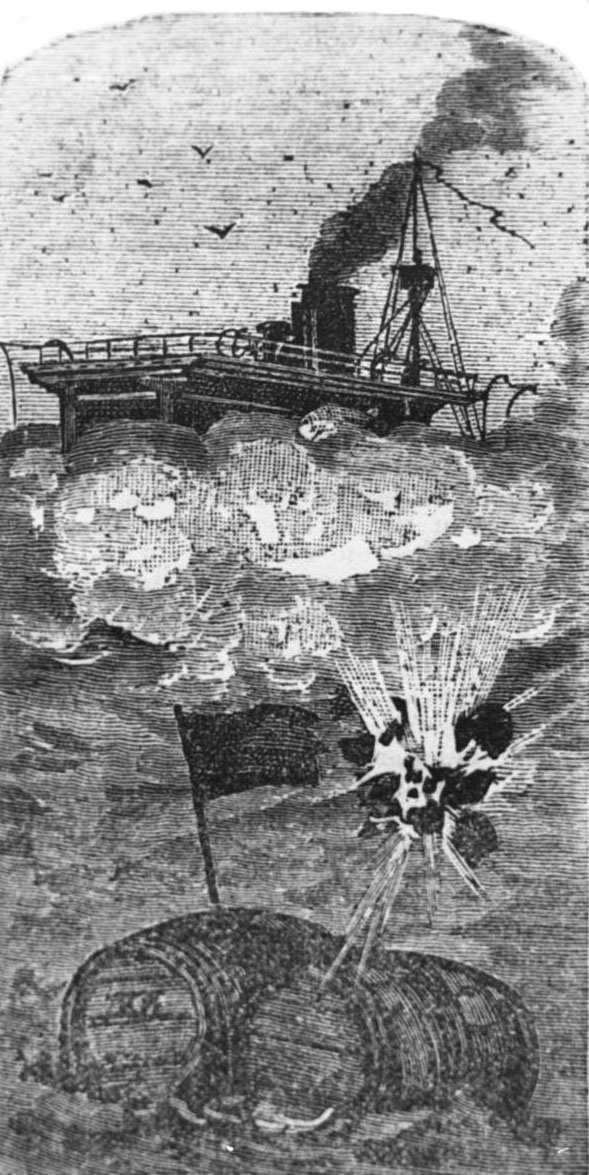
Broadside Firing.
The ships of the Victorian squadron, after taking stores at Williamstown on Monday afternoon, weighed anchor again, and steamed down the bay against a head wind and in a choppy sea. They lay during the night in the West Channel, and early this morning they dispersed for firing practice. On the flagship a special interest attached to this work, as the new director was to be subjected to a practical test.
The director consists of a horizontal arc, and a support carrying a telescope which is worked on trunnions, and provided with the vertical correction arcs and verniers. The horizontal arc is a semi-circular frame graduated in degrees representing bearings before and abaft the beam. It enables the manipulator to ascertain the angle and elevation of an object, and to make corrections for the speed at which the vessel is steaming. The instrument has been in use in the Imperial navy for many years. Its introduction to the Cerberus is one of the improvements which have been made by Captain Thomas since his return from England. It is intended to be used for broadside firing. For this purpose it is shipped on the conning tower, which is the station occupied by the commander in action. It gives the commander entire control over the fire, and enables him to deliver it at any time, and on any point he may select. He has an all-round view, and he would often see the object when it is out of sight from the gun deck owing to the smoke, darkness, or direction. He takes his sight with the director, he gives his advice with regard to angle and elevation to the man in the turrets by means of speaking tubes, and he fires the guns simultaneously by simply turning a key in the battery of the electric gear. The electric gear on the Cerberus is not complete, and the firing has to be done by the men themselves. It is, however, in process of construction.
For the practice which took place to-day a target, consisting of two barrels moored together and carrying flags, was sent afloat. Commander Collins occupied the conning tower, and Captain Thomas superintended the operations generally from the quarter deck. The order was first given for the broadside firing on the port beam. A concentrated broadside from the Cerberus would have destructive effect upon any object it struck. There are two turrets, four 18-ton guns. Seventy pounds of powder are used in each charge, and the weight of the projectile is 400lb. The weight of metal discharged would therefore be 1,600lb, and if the shots struck in the same spot they would make an impression upon the most heavily armoured ironclad, whilst they would at once sink any vessel of ordinary calibre. The distance given for the first shot was 1,000 yards beyond the target; but the direction was good, and if a Russian ironclad had been there it would have received the whole weight of the charge, which, unless it was a vessel of great strength, would have disabled or sunk it. The second broadside was fired with even better result. One of the flags was struck, and the projectiles dipped in the water only five yards beyond the target. The concentration was so complete that all the shots would have hit a target 10ft. square. One of the projectiles was seen to burst over the object. It is probable that it collided with another of the shot, and that the impact caused the explosion. The projectiles do not at once sink. In this instance they made two long hops after they first came into contact with the water, and then when their momentum was spent they disappeared. The Cerberus literally trembled when the broadside was fired. A cloud of smoke and burnt saltpeter enveloped the ship, soot and paint were shaken from the funnel, and the shield deck around, the turret was blackened. Captain Thomas, being satisfied with the results obtained, gave the order for independent firing on the port beam. In this practice the gunners themselves sight and fire the guns; but the distance was ascertained by Captain Thomas by a trial shot from the Nordenfelts. Only three shots were fired, the distances varying from 1,550 to 1,700 yards. The target was not hit; but two of the projectiles fell close to it, and would have struck a vessel lying in the same position. The target was drifting with the tide. Had it been stationary the results would have been better.
At about 11 o'clock Captain Thomas signalled for the other ships to form in column of division line, and in that information they steamed towards Queenscliff. On reaching the pile light they lay-to, and Captain Thomas then gave orders for the disposition of the fleet. The Albert was sent to Dromana, with instructions to engage in signalling practice by the electric light with the Victoria at Queenscliff. The Cerberus was to lie off Queenscliff and to exchange signals in the same way with the forts. The other ships of the squadron were ordered to remain at the north end of the West Channel, and to go through a programme of routine drill drawn out for them by Captain Thomas.

